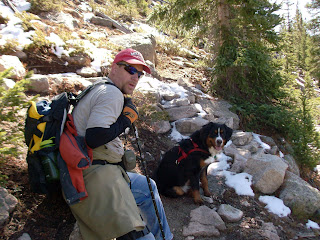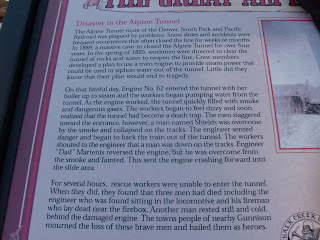MT. HURON LOCATION SOME PHOTOS TAKEN WITH 2 MP CELL PHONE OTHERS WITH 5 MP CAMERA
Sadly We came down. We went to 12,000 FT could not make 14,005 FT the fear hights gets to me, Bummer.
----------------------------
THE GHOST TOWN OF VICKSBURG LOCATION
-----------------------------------
GHOST TOWN OF ST. ELMO LOCATION
--------------------------------------
ON WARD TO ALPINE TUNNEL LOCATION
YES IT LOOKS LIKE ITS A GONER BUT STILL UP I WAS UP HERE 25 YRS AGO STILL THE SAME
BOX CARS FROM 18-EARLY 1900'S
YOU CAN STILL SE THE TIES
OLD RAILROAD BED
JOZEY LOVES THE SNOW
WE WERE @ 11,600 FT
TUNNEL NO MORE
-------------------------------------------------------
Website with more info
The curse of Alpine
Ill conceived and ill fated, Alpine Tunnel only served for twenty-eight years (off and on)
© Glen Brewer
one person wrote
(Nov 2, 2015)
My great grandfather was James DeGraff, he worked on the construction of this tunnel.These are the first pictures I have ever seen, I have to say the reality of it pretty much matches what was in my imagination.
-----------------------------------------------------
BUENA VISTA CO DOWNTOWN PARK LOCATION
WALKING EAST OF BUENA VISTA
Trail takes hikers back in time to Alpine Tunnel
If You Go
The trailhead for the east portal of the Alpine Tunnel starts just beyond the
ghost town of Hancock (east of Gunnison) where Forest Road 295 ends in a small
parking lot. From there, a three mile long trail follows the old grade to the
tunnel. The Forest Service has added interpretive signs along the trail to
explain the railroad's history. As a note of caution, the road beyond St. Elmo
is more suitable for an SUV.
It was also a race with the Denver & Rio Grande to reach Gunnison. The latter wisely picked a conventional route over Marshall Pass, while the Denver, South Park & Pacific embarked on a daring scheme to drill a tunnel under the Continental Divide.
West of Buena Vista, a route was surveyed up Chalk Creek Canyon. Bids were let in 1879, and the following year, work started on the tunnel from both the east and west portals.
Materials were hauled over primitive wagon roads to the sites. Weather above 11,000 feet at the portals often delayed construction. The worst problem was keeping laborers at these elevations. Normally, the railroad paid $4.50 to $5 a week (with room and board), but it soon discovered that even $3 a day was still was not attractive enough to keep the required work force.
Another problem was the geology of the area. Nearby mines penetrated hard, metamorphic rock and it was thought that the Alpine Tunnel would be through similar rock. The tunnel, however, went between two mountains that were filled in with loose material. This meant that almost every inch of the 1,800-foot tunnel had to be lined with heavy 12-inch-by-12-inch timbers.
Despite the difficulties, trains were running through the tunnel by December 1880.
To provide comfortable living conditions for the men, the Atlantic Construction Camp was established about 100 yards from the portal. It consisted of at least seven log structures. Most had a fireplace and all were made from large notched logs. The remains of these structures can be found in the trees near the portal.
The Denver, South Park & Pacific went bankrupt nine years after the tunnel was completed, and its assets were purchased by the Union Pacific. In 1910, a cave-in dropped debris for about 100 feet and no attempt was made to clear the tunnel. The track from the west portal to Gunnison and farther to coal mines at Baldwin was sold to rival Denver & Rio Grande.
In 1923, most of the rail was removed from both sides of the tunnel.
Today, it is an enjoyable hike into history.
Kenneth Jessen has been a Loveland resident since 1965. He is an author of 18 books and more than 1,300 articles. He was an engineer for Hewlett-Packard for 33 years and now works as a full-time author, lecturer and guide.
















































































No comments:
Post a Comment